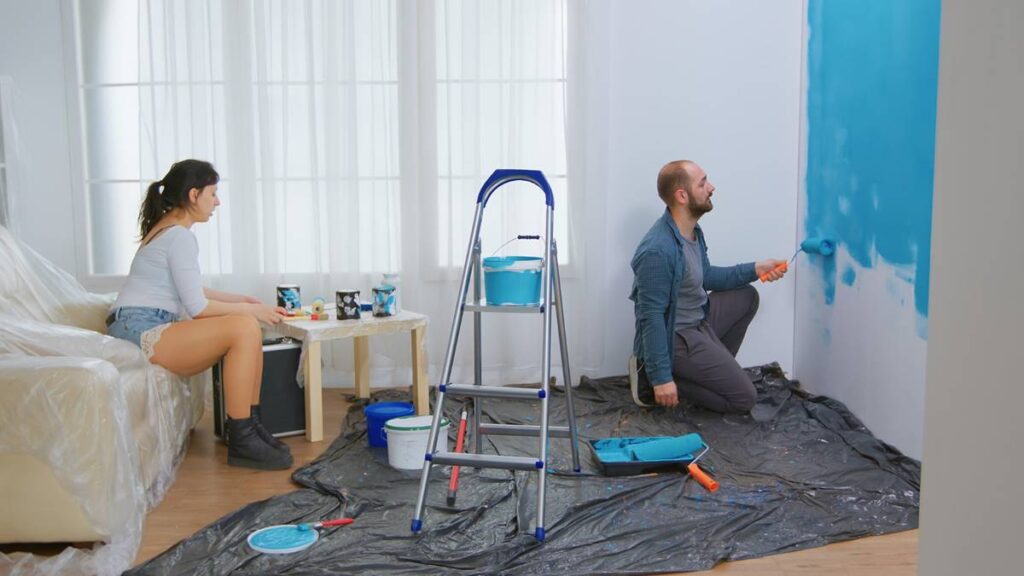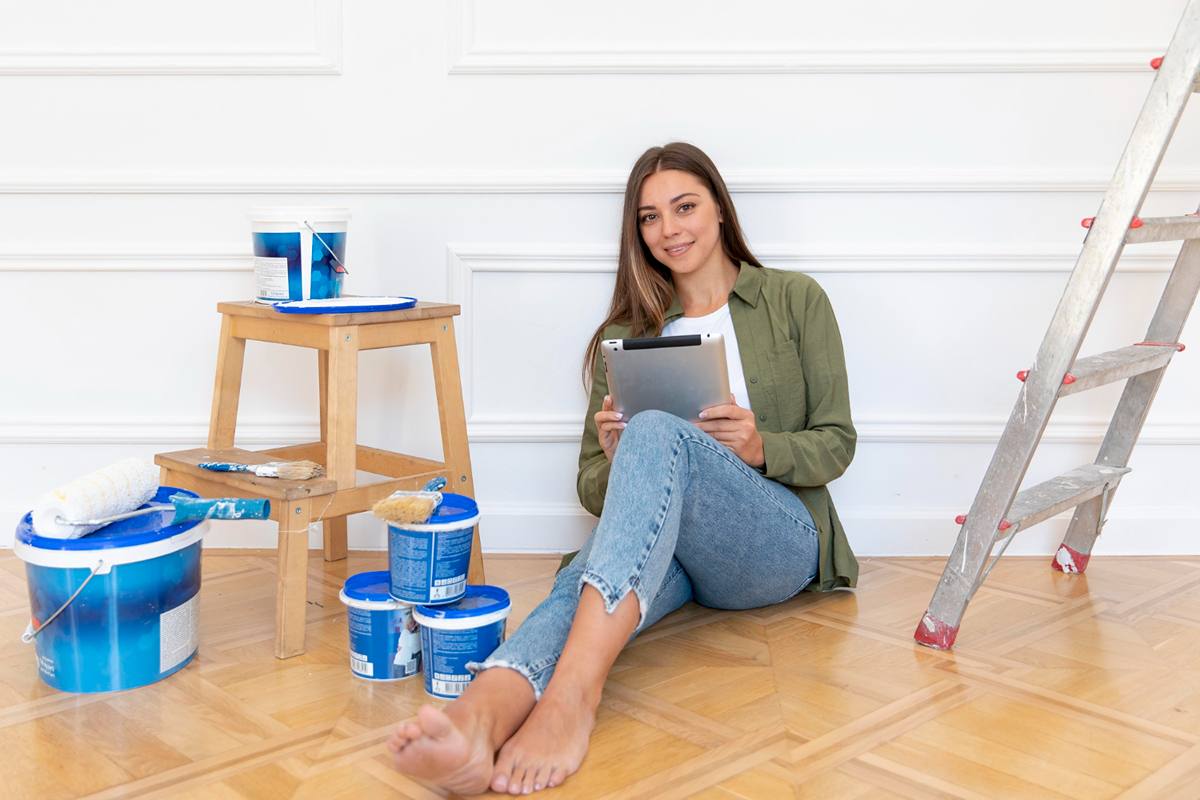If you’re wondering what type of paint for bathroom works best, the answer depends on one main thing: moisture. Bathrooms are full of steam and water, which can make paint peel, bubble, or grow mold. That’s why you need paint that is moisture-resistant, easy to clean, and made to last in wet places. Satin and semi-gloss latex paints are often the best choices for walls, while mildew-resistant flat paint works well on ceilings. Even bathroom tiles can be painted with special tile paint. Choosing the right paint keeps your bathroom fresh, safe, and looking new for years.
Why the Right Bathroom Paint Matters
Bathrooms are different from other rooms because they’re always wet or steamy. When you take a shower or use hot water, moisture builds up in the air. If you use the wrong paint, that moisture can cause big problems.
Bad paint choices can lead to:
- Peeling or bubbling paint
- Cracks on the wall
- Mold and mildew growth
What Type of Paint for Bathroom Walls
When it comes to bathroom walls, you need paint that can handle water and still look good. Two of the best choices are:
Satin Finish
- Has a soft shine
- Easy to wipe clean
- Looks smooth and modern
Semi-Gloss Finish
- More shiny than satin
- Highly water-resistant
- Great for high-moisture areas like near the shower
Latex Paint for Bathroom Walls
Latex paint is one of the most popular types for bathroom walls because:
- It’s easy to apply and dries quickly.
- It has low odor, so your bathroom won’t smell like chemicals.
- Many latex paints are made with moisture-resistant formulas.
- It’s safe and great for kids’ bathrooms too!
Moisture Resistant Paint for Bathrooms
A regular wall paint won’t work well in bathrooms. Why? Because it can’t handle the steam and water. That’s where moisture-resistant paint comes in.
These paints are specially made to:
- Stop mold and mildew
- Resist water damage
- Stay strong even in steamy air
Most bathroom paints today also include mildew-resistant additives. These help keep your walls looking fresh and stop dark spots or stains from showing up.
Best Brands That Offer Moisture-Resistant Paint
Here is a quick table comparing some popular paint brands that offer high-quality bathroom paints:
| Brand | Finish Type | Features | Price Range |
| Benjamin Moore | Satin, Semi-Gloss | Mildew-resistant, easy to clean | $$$ (High) |
| Behr | Satin, Semi-Gloss | Moisture-resistant, affordable | $$ (Medium) |
| Dulux | Soft Sheen, Mid-Sheen | Mold protection, good for ceilings | $$ (Medium) |
| Zinsser | Semi-Gloss | Best for tough mildew problems | $$ (Medium) |
What Type of Paint for Bathroom Tiles

If your bathroom tiles look old or dull, don’t worry — you can paint them! But you can’t use regular wall paint on tiles. You need special paint made for tiles, like epoxy or enamel-based paints.
Here’s a simple step-by-step guide to paint bathroom tiles:
- Clean the tiles well – remove dirt, soap, and grease.
- Sand the surface – this helps the paint stick better.
- Use a tile primer – it makes a smooth base for paint.
- Apply tile paint – use epoxy or enamel-based paint.
- Seal it – use a clear sealer to make it last longer.
What Type of Paint for Bathroom Ceiling
When it comes to painting the ceiling in your bathroom, choosing the right type of paint is very important. Why? Because the ceiling is where most of the steam and moisture goes after a hot shower.
The best type of paint for bathroom ceilings is a flat or matte finish that is moisture-resistant. These finishes don’t reflect much light, so they hide any small cracks or bumps. Plus, they help prevent peeling and bubbling caused by steam.
Avoid glossy or shiny finishes on the ceiling — they can show every little flaw and don’t do well in humid conditions.
Mold-Resistant Ceiling Paint Options
To protect your bathroom ceiling even more, you can use mold-resistant paint. These special paints have ingredients that stop mold and mildew from growing, even in very wet bathrooms.
Here are some top mold-resistant ceiling paint brands:
- Zinsser Perma-White Mold & Mildew-Proof Paint
- Finish: Flat or Satin
- Great for ceilings and walls
- Self-priming and long-lasting
- Finish: Flat or Satin
- Benjamin Moore Aura® Bath & Spa
- Finish: Matte
- Designed for high humidity
- Mold- and mildew-resistant
- Finish: Matte
- Behr Premium Plus Ultra Ceiling Paint
- Finish: Flat
- Moisture-resistant and great coverage
- Low odor and easy to clean
- Finish: Flat
Bathroom Paint Finishes: What to Choose?
When it comes to bathroom paint, the finish of the paint is just as important as the type of paint you choose. Different finishes work best in different areas of the bathroom. Here’s a quick guide to help you decide which finish is right for your bathroom.
Flat Finish: Best for Ceilings
Flat paint is a great choice for ceilings. It hides imperfections, doesn’t reflect light, and helps prevent moisture from causing paint to peel. However, it doesn’t clean as easily as other finishes, so it’s not the best choice for walls or high-traffic areas.
Eggshell Finish: Not Suitable for High Moisture
Eggshell finish has a slight sheen and is a popular choice for living rooms or bedrooms. But in a bathroom, it doesn’t resist moisture well. It’s not the best choice for high-humidity areas, like near the shower, where mold and mildew could develop.
Satin Finish: Best Balance
Satin finish offers the perfect balance between easy cleaning and moisture resistance. It has a smooth, slightly shiny surface and holds up well in bathrooms. It’s perfect for walls and moderate moisture areas, providing both durability and style.
Semi-Gloss Finish: Ideal for Most Bathrooms
If you’re looking for a paint that can handle heavy moisture and frequent cleaning, semi-gloss is a great choice. It’s water-resistant and shiny, making it ideal for bathroom walls, especially around sinks, showers, and tubs. It also reflects more light, brightening up the room.
Gloss Finish: Good but Can Look Too Shiny
Gloss finish is highly reflective and can make your bathroom walls look shiny and bright. While it’s very moisture-resistant and easy to clean, it can also highlight imperfections on the surface. It’s better for trim or doors rather than large walls, as it can be too shiny for some people’s taste.
Satin Paint for Bathroom: Is It Good?
Satin paint is often considered the best option for bathroom walls because of its moisture resistance and easy-to-clean surface. Here’s why it’s a great choice:
- Easy to Clean: Satin paint doesn’t stain easily and can be wiped clean with a damp cloth, making it perfect for bathrooms that need frequent cleaning.
- Resists Moisture: It handles bathroom humidity well, keeping the paint from peeling or bubbling.
- Smooth Finish: It provides a subtle sheen that looks attractive without being too shiny.
What Type of Paint for Small or No-Window Bathrooms

Small bathrooms or bathrooms with no windows are challenging environments because they tend to trap more moisture. Without proper ventilation, mold, mildew, and peeling paint can quickly become problems.
Use High-Gloss or Semi-Gloss Paint for Light Reflection
For small or windowless bathrooms, high-gloss or semi-gloss paints are the best choices. These finishes are highly reflective, which helps bounce light around and make the space appear larger and brighter. They also provide a water-resistant surface, making them ideal for high-moisture areas like bathrooms.
Add Dehumidifier Tips for Extra Protection
In addition to choosing the right paint, you should also consider using a dehumidifier in your small or windowless bathroom. A dehumidifier helps reduce the amount of moisture in the air, preventing mold and mildew from forming on the walls and paint. It’s a great way to protect your paint job and keep your bathroom fresh.
Dehumidifier Tips:
- Place the dehumidifier in the corner of the room to ensure even moisture control.
- Use it regularly, especially after showers or baths, to keep the air dry.
- Choose a compact, quiet dehumidifier that won’t take up too much space.
Extra Tips for Long-Lasting Bathroom Paint
To ensure your bathroom paint lasts longer and stays looking fresh, you can follow a few simple tips. These steps will help protect your bathroom walls from moisture, mold, and wear, keeping your space vibrant and clean for years.
Always Use Primer (Especially on Tiles and Ceilings)
Before you start painting, always apply primer. Primer acts as a protective barrier between the surface and paint, helping it stick better and last longer. It’s especially important on tiles and ceilings, which are exposed to high humidity. Using a high-quality primer ensures that your paint doesn’t peel or crack due to moisture.
Keep Bathroom Ventilated
Proper ventilation is key to maintaining the quality of your paint job. Moist air can cause paint to peel and mold to grow, so make sure to ventilate your bathroom well. Open windows when possible, and install an exhaust fan if your bathroom doesn’t have one. This helps remove excess moisture and prevents damage to your painted walls and ceiling.
Use Anti-Mold Sealant Where Needed
In areas with high moisture, such as around the shower or near bathroom sinks, consider using an anti-mold sealant. This sealant can be applied over the paint to provide extra protection against mold and mildew. It forms a protective layer that stops mold from forming, keeping your bathroom healthier and your paint looking fresh.
Repaint Every Few Years for a Fresh Look
Even with proper care, bathroom paint doesn’t last forever. Repainting your bathroom every 2-3 years will not only keep it looking brand new, but it will also provide an opportunity to check for any mold, mildew, or peeling issues. Regularly freshening up the paint will help protect your bathroom surfaces and ensure that the paint continues to perform well against moisture and humidity.
FAQS
What type of paint is best for a bathroom?
The best paint for a bathroom is satin or semi-gloss latex paint. These finishes are moisture-resistant and easy to clean, making them perfect for high-humidity areas.
Do I have to use special paint for bathroom?
Yes, special moisture-resistant paint is recommended for bathrooms. It prevents mold, mildew, and peeling, ensuring long-lasting durability in humid environments.
What kind of paint is best for humidity in bathrooms?
Semi-gloss or satin paints are ideal for high humidity areas. They resist moisture, mold, and mildew, offering durability and easy maintenance.
What is the best painting for bathroom walls?
The best paint for bathroom walls is satin or semi-gloss latex paint. These finishes are water-resistant and provide a smooth, easy-to-clean surface.
Is bathroom paint acrylic?
Yes, many bathroom paints are acrylic-based. Acrylic paints are water-resistant, durable, and provide excellent protection against moisture.
What primer to use in a bathroom?
Use a moisture-resistant primer for bathrooms. It helps improve paint adhesion and prevents mold or mildew growth, especially on walls and ceilings.
Best paint for bathroom walls and ceiling
Satin or semi-gloss latex paints are the best for bathroom walls and ceilings. These finishes are moisture-resistant and easy to clean, ensuring long-lasting protection.
Bathroom paint vs regular paint
Bathroom paint is specially formulated with moisture-resistant properties, unlike regular paint which may peel or mold in high-humidity areas like bathrooms.
Can I use satin paint in bathroom?
Yes, satin paint is a great choice for bathrooms. It offers moisture resistance and is easy to clean, making it perfect for high-humidity spaces.
Is latex paint OK for bathroom?
Yes, latex paint is ideal for bathrooms. It’s moisture-resistant, fast-drying, and provides a durable finish, especially when used in combination with the right primer.
Conclusion
Choosing the right type of paint for bathroom is essential for ensuring your bathroom looks great and stays protected for years. The right paint not only enhances the appearance of your space but also offers protection against moisture, mold, and peeling.
For most bathrooms, starting with satin or semi-gloss latex paint is a smart choice. These finishes provide the perfect balance of moisture resistance, easy cleaning, and durability, making them ideal for both walls and ceilings. With the right paint and a bit of extra care, your bathroom can maintain its fresh, vibrant look for a long time.
Remember, the right paint for bathroom ensures your space stays beautiful, protected, and functional for many years. Don’t forget to apply primer, keep your bathroom ventilated, and use anti-mold products to extend the life of your paint.










